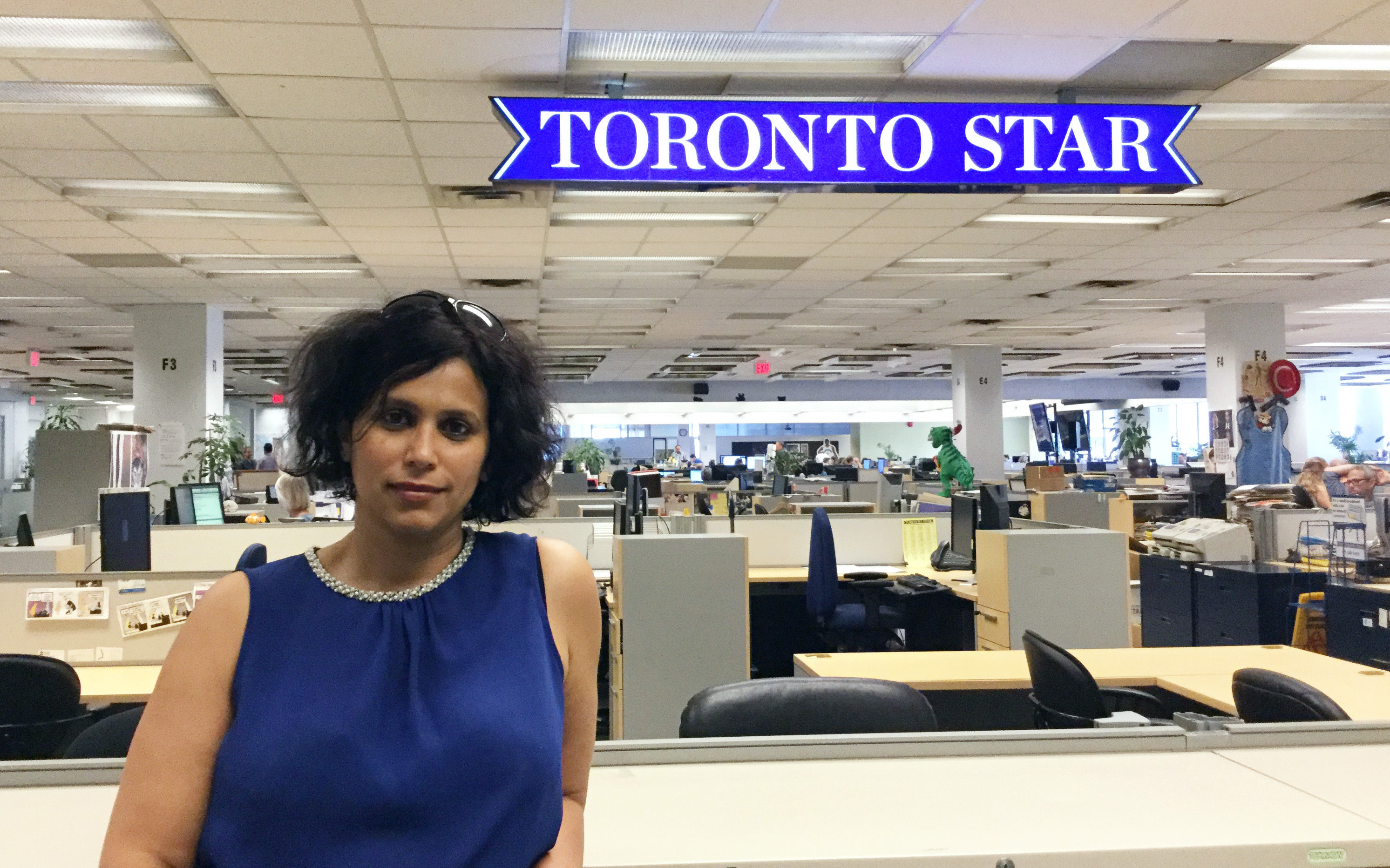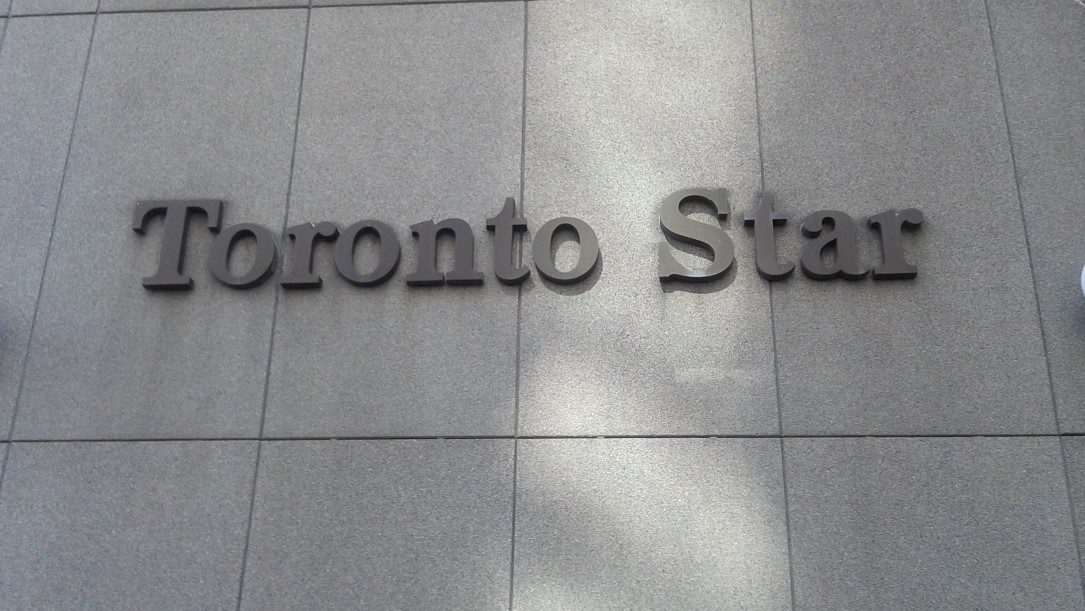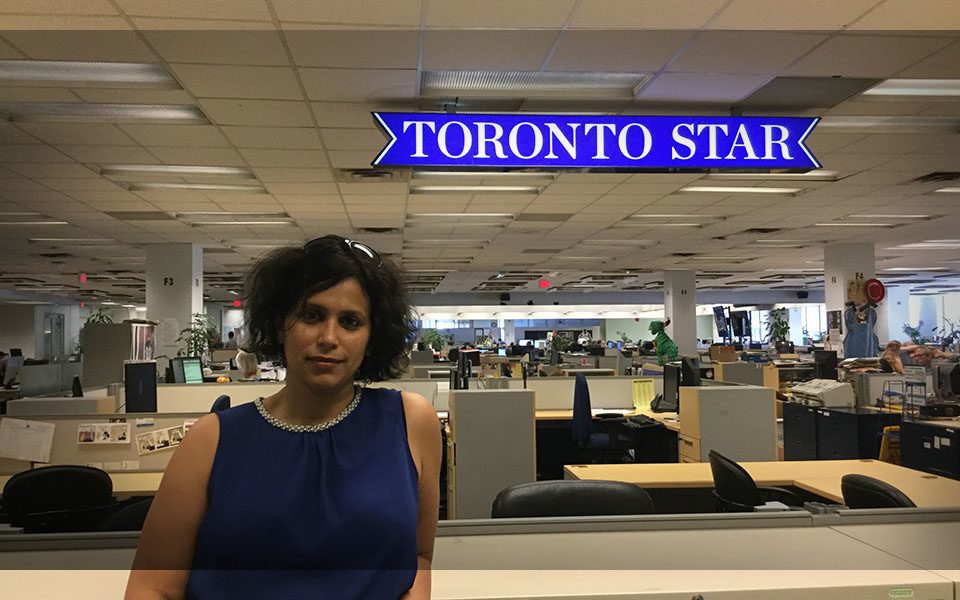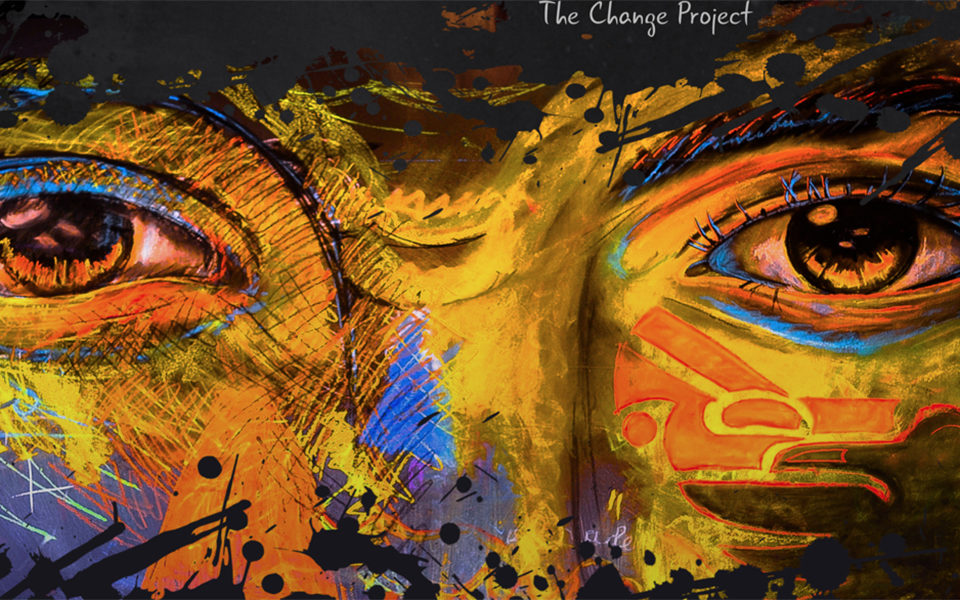
Hundreds of desks greet visitors in the giant newsroom at 1 Yonge St. It’s a quiet Thursday morning as Shree Paradkar leads the way to a table at the back. Her dark, curly hair, cut short hangs above her shoulders and kajal frames her brown eyes.
November marks a year since Paradkar began writing a column about identity and discrimination at the Toronto Star, issues she had sporadically written about before.
Hired by the Star in 2006, Paradkar has held many positions, including deputy digital editor, home page editor, and editor of Desi Life, a magazine aimed at a South Asian audience and produced by the Star. She came into this new role in the fall of 2016, “amid broader changes at the Star and during an immensely sad time,” writes Irene Gentle, the Star‘s managing editor, in an email. The Star’s reporter Raveena Aulakh had died by suicide in May, leading to a review of the newsroom’s culture and a series of changes.
Initially branded as a race and gender column, Paradkar says discrimination and identity more accurately reflect what she covers. With her very first column, she launched into a critique of systemic newsroom discrimination, adding personal anecdotes: “Every time someone tells me I was hired in this, that or the other job because I’m a woman and of colour, I bite my tongue and roll my eyes,” she wrote last November. “The next time, though, I’m going to #MakeItAwkward and say, ‘No. The fact is, YOU were hired because you are white.’”
She isn’t shy about criticizing her own newsroom, either. The same column calls the Star “unnaturally white” and blames it as the reason a film critic mistook the cultural term “code-switch” for “coat-switch” in an article on Moonlight. In another column, she defended former Star columnist Desmond Cole’s activism at a Toronto police board meeting, writing: “The fight for equality is changing its tone and without adequate representation in their newsrooms, traditional media are not keeping up.”
Although much of Paradkar’s work has been about race, she says it wasn’t easy to muster the courage to write a column on it. “I don’t necessarily want to talk about racism. I like to just do ordinary journalism, but nobody else is doing it,” she says. “Hopefully the next generation of people coming in are not reduced to having to talk about their identity.” Though Paradkar’s column is recent to the Star, writing about identity isn’t. Before Cole resigned, he was among the freelance columnists who regularly wrote about race at the Star. Full-time columnists like Royson James, Emma Teitel and formerly Haroon Siddiqui also explore discrimination in their work. But Paradkar’s column opens up a new space dedicated entirely to the subject.
Paradkar had pitched the race and gender column in August 2016, in response to an invitation from Gentle to staff for input on editorial changes. The column was something others at the Star also said was needed, Gentle says. “Journalistically, we were looking to be as relevant to our social justice principles as possible, looking for where we would do better,” she writes. But Gentle says that Paradkar’s column wasn’t the only addition to the Star’s new offerings. Jennifer Yang took on the identity and inequality beat and Emily Mathieu took the charge on chasing down affordable housing stories as part of this process. More recently, the publication has added a democracy beat. As for race and gender issues, Gentle says, “this intense and meaningful conversation was erupting all around us. In a city like Toronto, and a country like Canada, we need to be part of that.”

Paradkar is good fit at the Toronto Star, says Jeffrey Dvorkin, a lecturer and director of the journalism program at the University of Toronto’s Scarborough campus, pointing to the Atkinson Principles, which advocate for social justice and human rights. “There are advantages to people from the South Asian community doing stories on the South Asian community because they will bring a level of context that others might not be able to provide,” he says.
Initially, Paradkar wrote a weekly column while continuing her digital desk duties. “By the time May rolled around, it was obvious that we needed a lot more,” she says, noting the column performs well online (a claim Gentle agrees with, though she declined to share statistics). That month, Paradkar left her post as deputy digital editor to take on the column full-time. The decision made sense, says Gentle: “For a lot of reasons, race and gender issues and stories are fundamental in the history we are all living through and making right now. We couldn’t come close to capturing it with a part-time column.” She adds that though the whole newsroom is responsible for capturing this reality, Paradkar “helps analyze, guide and explain.”
But Dvorkin says newsrooms shouldn’t pigeonhole their reporters. “We need journalists whose conscience and background informs their journalism and makes it more accessible to the rest of us who may not be of that background,” he says. “Will the Star take their diversity reporter and send her to Ottawa to do stories that allow her to report on a broad range of subjects, using her background and her experiences to inform her journalism?”
Paradkar is also skeptical about using “checkboxes” to resolve the problem, though she does believe diversity needs to be considered a necessary part of the business, with concrete targets. “It does not mean hiring people because they’re people of colour. It means hiring the best, but recalibrating what you think ‘best’ means,” she says. “Best doesn’t mean someone who just graduated from the best university that you know. And best doesn’t mean somebody who can speak or have access to worlds that you are comfortable in. Best could also just mean that you can speak five non-European languages.”
Her advice for emerging journalists from minority backgrounds? “Don’t expect that you’re going to be treated as equal to everybody else,” she says. “Be aware and decide in advance what you’re willing to take and what you’re not willing to take.”
Update December 10, 2017: This story has been updated to include a note about other race columns at the Star before Shree Paradkar’s column was introduced.
About the author
Maria Iqbal is the 2017/18 editor of Ryerson Review of Journalism


1 comment
hahahaha PC in full force
Comments are closed.